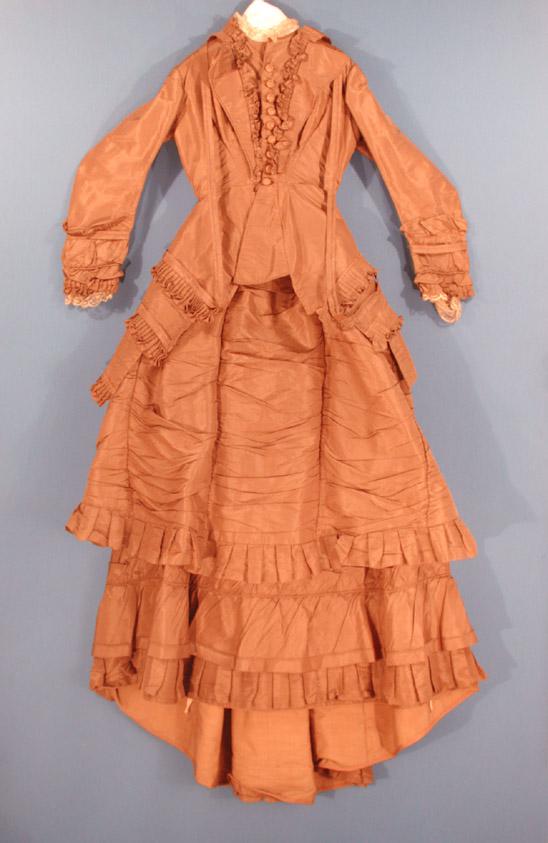Dress
Original OwnerOriginally owned by
Mary Elizabeth Carter
(American, 1842 - 1935)
Clothing MakerMade by
Unknown
Dateabout 1883
MediumMachine-stitched and hand-stitched silk and cotton, with velvet-covered ferrous metal buttons, brass hooks and eyes, ferrous metal hooks and eyes, and wool hem tape
DimensionsBodice (center front length x width across shoulders): 23 3/4 x 13 1/4in. (60.3 x 33.7cm)
Bodice (waist circumference): 21 1/4in. (54cm)
Skirt (center front length): 40 3/8in. (102.6cm)
Hem (circumference): 98in. (248.9cm)
Component (center front length of overskirt): 26in. (66cm)
Component (center back length of overskirt): 33 5/8in. (85.4cm)
ClassificationsCostume
Credit LineGift of Frances Ellen Brinley
Object number1958.42.2a-c
DescriptionWoman's three-piece day dress, consisting of a bodice (.a), skirt (.b), and overskirt (.c), made of brown ribbed silk, with brown silk satin trimming. The basque bodice is closely fitted, extending over the hips, and dipping deeply at center front. It is pointed at center back. The standing collar is 1 1/2 inches wide and is made of the brown satin. The bodice opens at center front and fastens with nineteen buttons, made of olive-brown velvet set in a brown satin bezel. The shoulderline is at the natural level; the long sleeves are tight and cut with a curve. The wrist openings are edged with brown satin, 2 3/4 inches deep. The bodice is fitted with two long darts on either side of the front, and with seven seams across the sides and back. There is no evidence that these seams were ever boned, as they would have been typically. Glazed brown twill-woven cotton is used as the bodice lining; the lower edge is lined with the brown satin.
The skirt is flat across the front. There is a narrow pleat over each hip, and then it is gathered across the back. The center back opening fastens with hooks and eyes at the waistband. At about knee-height, the skirt has a three-inch-wide ruffle of pleated self-fabric edged with satin above a nine-inch-deep bias flounce, also edged with bias satin. The lower edge of the skirt is surrounded by a six-inch-deep pleated ruffle. There is an in-seam pocket on the right side. The fullness of the skirt is controlled by tapes stitched in the lining; the tapes would tie behind the knees, thus keeping the skirt tight and smooth in front, and full in back. The lower skirt is lined to a depth of 18 1/2 inches with brown glazed cotton. The bottom of the skirt is edged with brown wool tape.
The drapery effect of the overskirt is created by rows of vertical gathering which pulls the fabric up in front of each hip. These gathered rows are decorated at their base with a self-fabric bow. The bottom of the overskirt is edged with bias brown satin. The center back panel of the overskirt extends in a square tail, with the edges embellished with a pleated band of self-fabric. This center back panel of the overskirt is pulled up with a wool tape and tacking stitches to create a bustled effect. More tapes stitched at the seams were fastened together to further keep the bustle in shape. The overskirt is not lined.
The skirt is flat across the front. There is a narrow pleat over each hip, and then it is gathered across the back. The center back opening fastens with hooks and eyes at the waistband. At about knee-height, the skirt has a three-inch-wide ruffle of pleated self-fabric edged with satin above a nine-inch-deep bias flounce, also edged with bias satin. The lower edge of the skirt is surrounded by a six-inch-deep pleated ruffle. There is an in-seam pocket on the right side. The fullness of the skirt is controlled by tapes stitched in the lining; the tapes would tie behind the knees, thus keeping the skirt tight and smooth in front, and full in back. The lower skirt is lined to a depth of 18 1/2 inches with brown glazed cotton. The bottom of the skirt is edged with brown wool tape.
The drapery effect of the overskirt is created by rows of vertical gathering which pulls the fabric up in front of each hip. These gathered rows are decorated at their base with a self-fabric bow. The bottom of the overskirt is edged with bias brown satin. The center back panel of the overskirt extends in a square tail, with the edges embellished with a pleated band of self-fabric. This center back panel of the overskirt is pulled up with a wool tape and tacking stitches to create a bustled effect. More tapes stitched at the seams were fastened together to further keep the bustle in shape. The overskirt is not lined.
Status
Not on view















